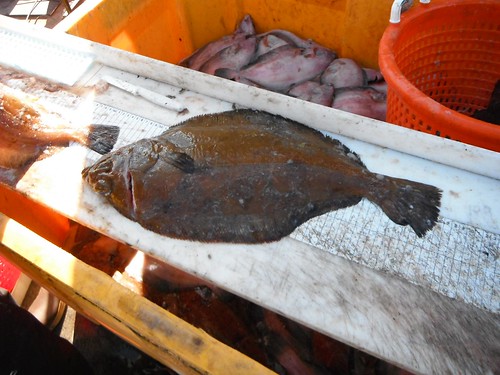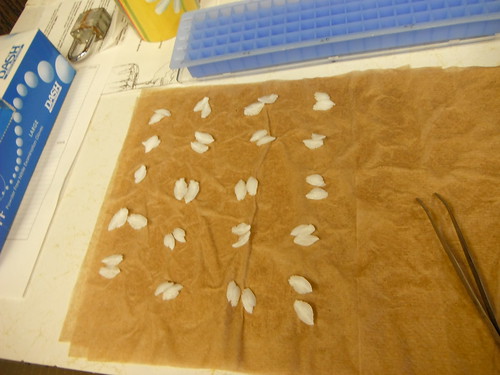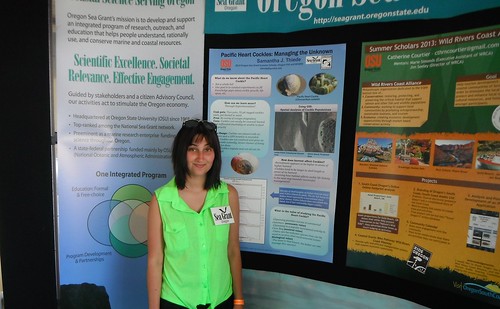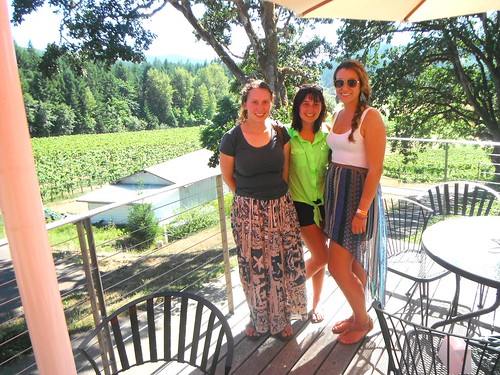Doing research is an essential part of the scientific process. In the scientific community, the epitome of valid research is having it published in a peer-review journal. Unfortunately, this is as far as many scientists go. But what about sharing your research with local communities, i.e., non-scientific audiences, that might be impacted by this research? What about connecting your research to a bigger picture? For the public to be able to make intelligent decisions in many areas–how to allocate the communities’ budget, what fish to eat, personal choices on use of plastic and other trash—they must be able to understand what is at stake.

Me presenting a poster at Land Sea Symposium in Yachats OR, sharing my research with other scientist and coastal community members. Photo: Cyndy Leoro
However, many in the scientific community have spent decades seemingly separating themselves from the non-scientific community. Scientists use a whole different vocabulary than the average person in an attempt to explain natural phenomena. They use complex statistical analyses to prove their theories, and some may even pride themselves in knowing what is best for the disadvantaged communities that are in need of a scientist’s help. But this is where we have gone wrong. As scientists, we have at times alienated ourselves into a bubble, stopped listening to others without fancy degrees, or have acted arrogantly towards those outside of the scientific community. Furthermore, many scientists find themselves embattled in the publish or perish dilemma, and may not see it as part of their job or even understand the importance of sharing their research outside of the scientific community.
Before I started my PhD at Oregon State, I was unaware of the importance of outreach and good science communication. It was at a NOAA internship at the Office of National Marine Sanctuaries in the Education, Outreach and New Media Division, where I learned what outreach was and its importance. Outreach gave me an opportunity to share my love and passion for the ocean and tell audiences why sea critters are so cool and why ocean resources are worth protecting and why I was so much in love with the work I was doing. In this manner, I also learned to love outreach.

NOAA’s yearly community outreach event. I got to help out and tell the communities about Marine Protected Areas, like National Marine Sanctuaries, and why they are important for Ocean conservation.
Once at Oregon State, I took my first science communication class with COMPASS. After addressing the American Association for the Advancement of Science (AAAS) with a call for a “New Social Contract with Science”, Dr. Jane Lubchenco and other like-minded scientists founded COMPASS on the “premise that ocean scientists, in particular, had a wealth of knowledge that was not reflected in public understanding or policy and management practices.” (Lubchenco 1998; Smith et al. 2013). In this class, students are encouraged to use a tool they developed called a message box to hone in on their main message, get rid of the jargon and tell their story (develop story-telling skills). I learned that while I may find my research to be absolutely fascinating, other people might find it more interesting if I tell them my story. In telling my story, I can also tell them about my research. Developing these story-telling skills is crucial for humanizing scientists and making our research more relatable. If you have ever been to a lecture in college or school, in which the professor drones on and on in a monotone voice on some obscure topic using vocabulary and examples that no one else but him seems to understand, then you have witnessed bad science communication. The difference with a teacher or professor with good science communication skills, is that you fell connected to the topic being discussed and want to learn more. The scientist or professor does not bog you down with jargon or all the nitty gritty details of the research. Rather the scientist or professor may tell you a story related to their research, or take you on a journey that gets the class intrigued on the subject. This skill is the hardest one to develop. Letting go of this jargon and the nitty gritty details of our research may at first seem impossible. As scientists, we are trained to be very cautious in the conclusion we read and specific in the language we use. However, when we communicate our science to general audiences we must learn to forgo that and get the main point across.
Having good science communication skills does not only mean being able to express yourself and explain your research eloquently, but having good listening skills as well. Too many times, scientists have alienated the communities which they wish to help or work with, by not listening to them. Going into a community with open ears and hearing what their concerns and research needs are and how you can help has been shown to result in much more successful collaboration, than going into a community with a mindset that I, the outsider scientist, know what is in the best research interest for you, the lay people. Local knowledge and wisdom have too often been ignored by many scientists, when they should be complimentary/collaborative to our research.

Kids area always super exited when they get to see and touch marine critters
Combining outreach with good science communication skills can help scientists connect their research with communities that may be affected differently, get public support for their work, inform policy to make the best science-based decisions, increase collaboration opportunities, inspire a next generation of scientists, make a difference, and possibly even get more funding for this research.

I had the great opportunity to teach kids about Marine Protected Areas with a game I created for them

I got to explain to kids what Marine Protected Areas are and why they help fisheries
Personally, I particularly love going to schools and telling kids about the ocean, seeing their face light up with fascination as I show them pictures of odd and beautiful sea creatures and answering their questions about the sea. I love answering questions from my friends about how to make smart choices when it comes to sustainable fisheries and about the health of our oceans’ marine resources. I love it when a stranger on a plane asks me what I do, and I get to tell them about all about some of the cool things I get to do for my research, like going fishing. My goal in life is to make a difference in conservation of ocean resources and ensure sustainable fishing practices so that we can continue to fish for generations to come. I hope that through the outreach work I do and the improved science communication skills I have acquired, I can inspire others to take care of our oceans whether by taking small steps such as helping in local cleanups or using less plastic, or by one day becoming scientists in this fascinating field.

Best part of doing outreach is that I get to have fun, work with amazing people that also love the ocean, share my knowledge, and its a great opportunity to be silly once and a while
Lubchenco, J. 1998. Entering the Century of the Environment: A New Social Contract for Science. Science 279(5350):491–497. American Association for the Advancement of Science.
Smith, B., N. Baron, C. English, H. Galindo, E. Goldman, K. McLeod, M. Miner, and E. Neeley. 2013. COMPASS: Navigating the Rules of Scientific Engagement. PLoS Biology 11(4):e1001552. Public Library of Science.










